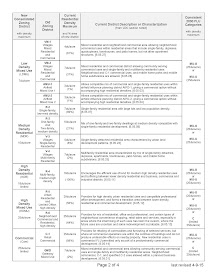This is what the zoning map for the Northwest portion of district I looked like prior to 2015. In speaking with county staff--the impetus at the time the decision was made to simplify and consolidate the zoning designations--- was to not diminish the property rights or zoning rights of existing property owners. So, when we went from this zoning, below,
to what the zoning districts look like today, below, we now know what the thought process was that drove the decision making. This is, below, what the zoning for this same section of District 1 looks like today.
Unfortunately-----this well-intentioned, well-meaning strategy also led to the conditions that we are seeing today in Beulah.
Growth that is out of control.
Below is a table describing, in detail, the "before and after" zoning designations and changes.
A quick read of these will illustrate, very quickly, the conditions by which the growth was facilitated by this well-intentioned action.
What we see today in 2019 is a result, in part, of this change. See the before/after zoning changes below....






My property (and some surrounding area) was changed from Agricultural to higher density areas with the stroke of a pen. One of the reasons I always appreciated my place was the protection that the AG provided against higher density areas adjacent to my property. So yes, it most definitely has the feeling of lost property rights. I do however understand some the reasons why it was needed, but getting the buy-in a the the property owner prior to zoning changes should definitely have occurred.
ReplyDeleteZoning changes like these make existing landowners suspicious that developers are somehow involved in planning issues, since it paved the way for massive development.
This is informative, thanks. It is hard to determine by color what the zoning is on these maps, but you can go to the county's website, Planning and Zoning Department, and see the old as well as the new zoning named on the map.
ReplyDeleteA large part of Beulah has Low Density Residential zoning. In 2015, six categories of the old zoning were combined into the new Low Density Residential zoning category that allows up to four dwelling units (DU) per acre. Only two of old six categories had four DU, which was retained. The other four got 1 to 3 more DU in 2015. That meant four out of the six categories were effectively upzoned - so more houses could be built on that land.
The other thing that affected the number of houses that could be built per acre in Low Density Residential is the BCC change in the minimum lot width a couple of years ago - from a minimum of 70 feet wide to a minimum of 60 feet wide. Previously, the amount of land needed for roads and drainage ponds and lot width and setback requirements limited the actual number of homes that would physically fit on a site. But with less lot width required, developers can now get nearly all the maximum four DU on a site - even while building drainage ponds and roads.